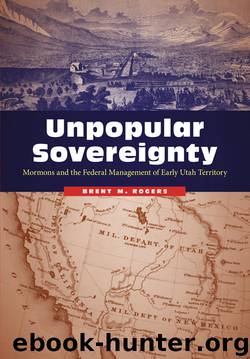Unpopular Sovereignty: Mormons and the Federal Management of Early Utah Territory by Brent M. Rogers

Author:Brent M. Rogers [Rogers, Brent M.]
Language: eng
Format: epub
Publisher: UNP - Nebraska
Published: 2017-02-01T07:00:00+00:00
FIG. 12. Chief Washakie (center) and other Shoshones. Used by permission, Utah State Historical Society.
Mormons also conducted visits and sent communications to Native peoples. It is unclear to what extent Mormons approached regional Native groups regarding such an alliance, or vice versa; it seems, however, some overtures were made. In mid-August 1857, Dimick Huntington met with various bands of Utes and Goshutes spreading the message that the army would kill the Mormons and then all of the Native peoples. Huntington told the Utes and Goshutes he met with that “they and the Mormons was one.” In early September 1857, Huntington and Young encouraged Anterro, a leader of the Uintah Utes, to “be at peace with all men except the Americans.”56 On 1 September 1857, Mormon Indian missionary Jacob Hamblin brought Kanosh, the Pahvant Ute leader, with several of his band to visit Brigham Young in Salt Lake City. After this meeting, Young’s diary reads, “A Spirit Seems to be takeing possession of the Indians to assist Israel. I can hardly restrain them from exterminating the ‘Americans.’ ”57 It seems clear that Mormons were attempting to form alliances with regional Native peoples against the coming army, though the exact nature of the alliance, including its size and strength, is not known. In the end, the alliance failed to materialize.
Still, Indian affairs continued to complicate the federal-territorial relationship in Utah. On 8 April 1857, President Buchanan appointed James W. Denver as the nation’s commissioner of Indian affairs.58 Prior to the arrival of Jacob Forney, Denver and Brigham Young conducted little correspondence, but they exchanged a few intense letters on Indian policy and the role of the army in Utah. Young, writing on 12 September with vouchers for expenditures on Indian affairs, reported that Native raiders had taken the lives of many emigrants and a great deal of property. He stated that the reason for the widespread raiding was the abhorrent practice of overland travelers “shooting at every Indian they could see.” Because of that practice, he suggested, “the Indians regard all white men alike as their enemies, and kill and plunder whenever they can do so with impunity, and often the innocent suffer for the deeds of the guilty.” Young’s equivocating statement implicitly dismissed the ideas of a Mormon-Indian alliance by likening all white people in relation to indigenous people. He continued, “It is hard to make an Indian believe that the whites are their friends, and that the Great Father wishes to do them good, when, perhaps, the very next party which crosses their path shoots them down like wolves. This trouble with the Indians only exists along the line of the traveled west, and beyond the influence of our settlements.” The Mormon leader further expressed his concern over the coming of the army. Though white settlers in other frontier territories typically requested military protection, the governor considered the stationing of the army in Utah superfluous. He considered its stationing in Utah to be counterproductive, even dangerous, because it created more volatility in relations with regional Indians.
Download
This site does not store any files on its server. We only index and link to content provided by other sites. Please contact the content providers to delete copyright contents if any and email us, we'll remove relevant links or contents immediately.
The Lost Art of Listening by Michael P. Nichols(6462)
Why I Am Not A Calvinist by Dr. Peter S. Ruckman(3766)
The Rosicrucians by Christopher McIntosh(3046)
Wicca: a guide for the solitary practitioner by Scott Cunningham(2702)
Signature in the Cell: DNA and the Evidence for Intelligent Design by Stephen C. Meyer(2495)
Real Sex by Lauren F. Winner(2466)
The Holy Spirit by Billy Graham(2408)
To Light a Sacred Flame by Silver RavenWolf(2350)
The End of Faith by Sam Harris(2279)
The Gnostic Gospels by Pagels Elaine(2023)
Nine Parts of Desire by Geraldine Brooks(2002)
Waking Up by Sam Harris(1953)
Heavens on Earth by Michael Shermer(1950)
Devil, The by Almond Philip C(1896)
Jesus by Paul Johnson(1882)
The God delusion by Richard Dawkins(1843)
Kundalini by Gopi Krishna(1821)
Chosen by God by R. C. Sproul(1754)
The Nature of Consciousness by Rupert Spira(1687)
